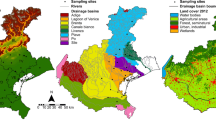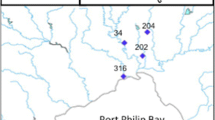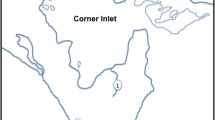Abstract
Introduction
Public and scientific concern has grown over the last decade in Canada over the cosmetic use of pesticides in urban centers. With this in mind, a national survey was designed to monitor eight commonly used herbicides in urban rivers and streams across Canada.
Materials and methods
To coordinate sample collections across the country, samples were collected monthly on one of two predetermined dates from April to September, 2007 from 19 sites within 16 watersheds, including 15 sites downstream of urban lands and two reference sites. Water samples were also collected approximately three times from each watershed during or after precipitation events. All samples were collected using a common sampling protocol and all were analyzed using the same analytical laboratories.
Results and discussion
The herbicides 2,4-D, mecoprop, dicamba, glyphosate and its major metabolite aminomethylphosphonic acid (AMPA) were most frequently detected. Using either herbicide concentrations upstream/downstream of urban centers or bromoxynil and clopyralid as indictors of agricultural inputs of herbicides to streams, it was clear that environmental concentrations of these herbicides downstream of urban areas were linked to urban use in Canada. Herbicide concentrations in streams draining urban areas were greater during or after significant rainfall events and, with the exception of glyphosate, were significantly greater in the Province of Ontario. Herbicide concentrations were not correlated to the proportion of the watersheds in urban land use. Also, there was no difference in seasonal patterns of herbicide concentrations across urban centers when grouped in five geographic areas. None of the herbicide concentrations measured exceeded existing Canadian Water Quality Guidelines for the protection of aquatic life.
Conclusions
This is the first time a national survey of pesticides in urban rivers has been carried out in a consistent fashion across Canada. Concentrations of 2,4-D, mecoprop, dicamba, glyphosate, and AMPA were linked to urban use and frequently detected in all geographic areas. However, geographic differences in concentration suggested differences in usage or stream connectivity patterns among urban centers. Some jurisdictions in Canada have recently restricted cosmetic use of pesticides and it would be interesting to determine whether such restrictions will lead to reduced pesticide concentrations in urban streams.





Similar content being viewed by others
References
Blanchoud H, Farrugia F, Mouchel JM (2004) Pesticide uses and transfers in urbanised catchments. Chemosphere 55:905–913
Blanchoud H, Moreau-Guigon E, Farrugia F, Chevreuil M, Mouchel JM (2007) Contribution by urban and agricultural pesticide uses to water contamination at the scale of the Marne watershed. Sci Total Environ 375:168–179
Botta F, Lavison G, Couturier G, Alliot F, Moreau-Guigon E, Fauchon N, Guery B, Chevreuil M, Blanchoud H (2009) Transfer of glyphosate and its degradate AMPA to surface waters through urban sewerage systems. Chemosphere 77:133–139
Byer JD, Struger J, Klawunn P, Todd A, Sverko E (2008) Low cost monitoring of glyphosate in surface waters using the ELISA method: an evaluation. Environ Sci Technol 42:6052–6057
CCME—Canadian Council of Ministers of the Environment (1999) Canadian Water Quality Guidelines for the Protection of Aquatic Life: in Canadian Environmental Quality Guidelines. Canadian Council of Ministers of the Environment, Winnipeg
Chacko VT, Gummer WD (1980) Content and distribution pattern of 2,4-D in the Red River. In: Environment Canada IWD (Hrsg.). Technical Bulletin, Regina, p 12
CropLife (2008) Annual Report, Toronto
Donald DB, Cessna AJ, Sverko E, Glozier NE (2007) Pesticides in surface drinking-water supplies of the northern Great Plains. Environ Health Perspect 115:1183–1191
Fatta-Kassinos D, Bester K, Kümmerer K, Haus N, Zimmermann S, Sures B (2010) Precious metals in urban aquatic systems: platinum, palladium and rhodium: sources, occurrence, bioavailability and effects. In: Alloway BJ, Trevors JT (eds) Xenobiotics in the urban water cycle. Environmental pollution. Springer, Netherlands, pp 73–86
Gilbert RO (1987) Statistical methods for environmental pollution monitoring. Wiley, New York, p 384
Gurr E, Nnadi F (2009) Non-point source nutrient loading in an urban watershed. ASCE, Kansas City, 140 pp
Hoffman RS, Capel PD, Larson SJ (2000) Comparison of pesticides in eight U.S. urban streams. Environ Tox Chem 19:2249–2258
Kolpin DW, Thurman EM, Lee EA, Meyer MT, Furlong ET, Glassmeyer ST (2006) Urban contributions of glyphosate and its degradate AMPA to streams in the United States. Sci Total Environ 354:191–197
Ontario Ministry of Agriculture and Rural Affairs (OMAFRA) (1994) Survey of pesticide use in Ontario, 1993. Economics and Policy Co-ordination Branch, OMAFRA, Guelph, Ontario
Phillips PJ, Bode RW (2002) Concentrations of pesticides and pesticide degradates in the Croton River watersheds in south-eastern New York, July–September 2000. US Geological Survey Water-Resources Investigations Report, Troy
Phillips PJ, Bode RW (2004) Pesticides in surface water runoff in south-eastern New York State, USA: seasonal and stormflow effects on concentrations. Wiley, New York, pp 531–543
Rawn DFK, Halldorson THJ, Woychuk RN, Muir DCG (1999) Pesticides in the Red River and its tributaries in southern Manitoba: 1993–95, 34. National Water Research Institute, Burlington, 37 pp
Shala L, Foster G (2010) Surface water concentrations and loading budgets of pharmaceuticals and other domestic-use chemicals in an urban watershed (Washington, DC, USA). Arch Environ Contam Toxicol 58:551–561
Struger J, Fletcher T (2007) Occurrence of lawn care and agricultural pesticides in the Don River and Humber River watersheds (1998–2002). J Great Lakes Res 33:887–905
Struger J, Boyter D, Licsko ZJ, Johnson BD (1994) Environmental concentrations of urban pesticides. In: James W (ed) Current practices in modelling the management of stormwater impacts. CRC, Boca Raton, pp 85–98
Struger J, Thompson D, Staznik B, Martin P, McDaniel T, Marvin C (2008) Occurrence of glyphosate in surface waters of Southern Ontario. Bull Environ Contam Toxicol 80:378–384
Tomlin C (2006) The pesticide manual. British Crop Protection Council (BCPC), 1350 pp
United States Geological Survey (1999) The Quality of our nation’s waters—nutrients and pesticides. U.S. Geological Survey Circular, pp. 82
Weston DP, Holmes RW, Lydy MJ (2009) Residential runoff as a source of pyrethroid pesticides to urban creeks. Environ Pollut 157:287–294
Wittmer IK, Scheidegger R, Bader H-P, Singer H, Stamm C (2011) Loss rates of urban biocides can exceed those of agricultural pesticides. Sci Total Environ 409:920–932
Yang Y, Metre PCV, Mahler BJ, Wilson JT, Ligouis B, Razzaque MM, Schaeffer DJ, Werth CJ (2010) Influence of coal-tar sealcoat and other carbonaceous materials on polycyclic aromatic hydrocarbon loading in an urban watershed. Environ Sci Technol 44:1217–1223
Acknowledgments
The authors gratefully acknowledge the sampling and analytical efforts by the staff of Environment Canada. We are also grateful for the GIS work and watershed delineation conducted by François Boudreault of Environment Canada. This monitoring project was funded by Environment Canada’s Pesticide Science Fund.
Author information
Authors and Affiliations
Corresponding author
Additional information
Responsible editor: Ake Bergman
Electronic supplementary material
Below is the link to the electronic supplementary material.
Fig. S1
Examples of river discharge for three rivers with distinct discharge regimes; 1 Highland Creek—frequent rainfall events with event discharge elevated well above base flow, 2 Bow River—a large river with mountain runoff dominated pattern with small impact of rain event on overall discharge, and 3 Swift Current Creek—a small river with infrequent and small rain events. Timing of water quality samples are indicated with an X; X EV indicates a sample classified as being obtained during an event (DOC 88.5 KB)
Fig. S2
Principal component analysis of concentrations of 2,4-D, mecoprop, dicamba, AMPA, and glyphosate for 90 water samples collected from 15 urban rivers between April 2007 and September 2007. Vector arrows show the direction of increasing concentration for each herbicide. Samples with highest concentrations of 2,4-D, mecoprop, and dicamba are located in the upper right quadrant; those with highest concentrations of AMPA and glyphosate, in the lower right quadrant. Expanded view (top) shows the spread of samples in the area with high sample overlap (DOC 105 kb)
Table S1
Pesticide physical–chemical characteristics of some pesticides detected in Canadian rivers (DOC 44.5 KB\)
Table S2
Water quality measurements during high discharge (June) and low discharge (September) sampling periods (DOC 96 kb)
Rights and permissions
About this article
Cite this article
Glozier, N.E., Struger, J., Cessna, A.J. et al. Occurrence of glyphosate and acidic herbicides in select urban rivers and streams in Canada, 2007. Environ Sci Pollut Res 19, 821–834 (2012). https://doi.org/10.1007/s11356-011-0600-7
Received:
Accepted:
Published:
Issue Date:
DOI: https://doi.org/10.1007/s11356-011-0600-7




